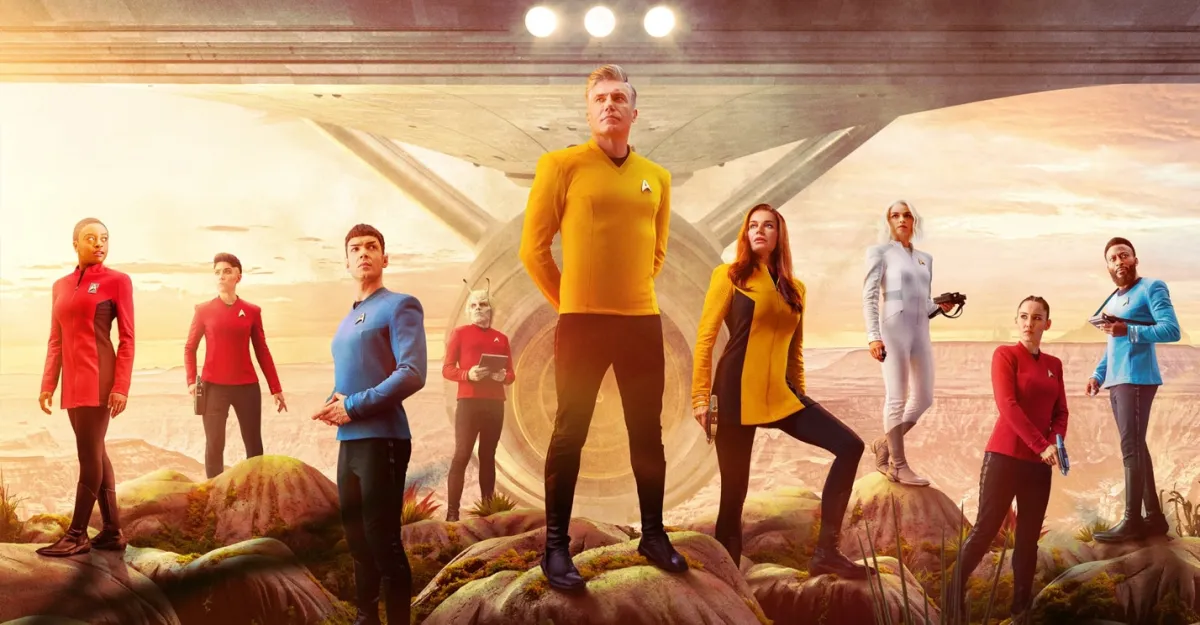This discussion and review contains spoilers for Star Trek: Strange New Worlds episode 1, “Strange New Worlds.”
Star Trek: Strange New Worlds is at least self-aware in its nostalgia.
The most interesting aspect of the show’s first episode, helpfully titled “Strange New Worlds,” is the way in which the series situates itself comfortably in its relationship to the past. This is, after all, a prequel series to the original Star Trek, focused on the cast of characters from the aborted 1964 pilot, and also a transparent attempt to return to the episodic model of storytelling that defined Star Trek until the third season of Star Trek: Enterprise.
The most forgiving read of “Strange New Worlds” is that the show understands this. Building off the second season of Star Trek: Discovery, Captain Christopher Pike (Anson Mount) is a haunted man. Following his “temporal consciousness displacement” on Boreth, he is aware of the fate awaiting him in “The Menagerie.” He knows what all Star Trek fans do: that the end of Christopher Pike’s story cannot be a good one.
“I know exactly when and how my life ends,” he explains at one point. “And I didn’t just see it. I felt it, every agonizing second.” In essence, Pike is trapped in a prequel to which he already knows the ending. It’s an effective metaphor for the perils of a project like Strange New Worlds, built on the understanding that this narrative is hemmed in by the confines of the established canon, give or take some ambiguous continuity about whether Starfleet knew about the Gorn before “Arena.”
“Strange New Worlds” approaches this central tension in an admittedly intriguing way. Early in the episode, Pike rewatches The Day the Earth Stood Still while preparing breakfast. It is a choice that situates Pike in the franchise’s past and future. The Day the Earth Stood Still is a product of 1950s American science fiction, predating the original Star Trek. However, it was also directed by Robert Wise, who would go on to radically redefine what Star Trek could be with The Motion Picture.

To its credit, Strange New Worlds has a better read on Christopher Pike than Discovery did. Pike is something of an oddity in the Star Trek canon. As played by Jeffrey Hunter in “The Cage,” Pike was a brooding and introspective protagonist, one nursing deep traumas. Part of the problem with “The Cage” was that it was a story about a man who spent most of the story actively resenting exploration and adventure. Hunter had gravitas and intensity, but the show needed William Shatner’s charm.
As the living embodiment of a version of Star Trek that never actually existed, one replaced by “Where No Man Has Gone Before” and clumsily folded back into continuity in “The Menagerie,” Pike has long been an object of fascination for Star Trek fans. There have been novels and comics written about the character. Bruce Greenwood offered a compelling take on the character in J.J. Abrams’ first two Star Trek movies. Pike is a historical curiosity, a fascinating footnote in the larger canon.
A significant part of “Strange New Worlds” is given over to reconciling Anson Mount’s portrayal of Pike with the legacy of Jeffrey Hunter. “Strange New Worlds” consciously riffs on two of Hunter’s most iconic screen roles, performances that would undoubtedly have shaped how audiences would have reacted to him as the lead actor in a late-1960s space exploration show.
“Strange New Worlds” presents Pike as a futuristic cowboy, living on his ranch in Deer Creek, Montana. The setup recalls Kirk’s (Shatner) experience of the Nexus in Star Trek Generations, down to the captain’s preparation of breakfast for a female companion before being recalled to active duty. There are beautiful shots of Pike on horseback as the shuttle sweeps in to collect him, drawing a connection to Hunter’s iconic role in John Ford’s classic western The Searchers.

However, “Strange New Worlds” draws a much stronger connection to Hunter’s other memorable screen role. Hunter played Jesus Christ in Nicholas Rey’s King of Kings. In its own way, “Strange New Worlds” positions Pike as a Christ-like figure. Not only does Pike represent the dawn of the Star Trek franchise, but he is burdened with the foreknowledge of his own death and the question of whether or not he is willing to follow through on that self-sacrifice knowing that his suffering will save others. He is even reintroduced with a nice scruffy beard.
The show’s approach to Pike is compelling as a character concept and as a piece of self-aware meta-fiction. Pike’s knowledge of his own fate allows Strange New Worlds to grapple with the fact that the futuristic world of Star Trek has become increasingly trapped and defined by a nostalgic pull to the past. This is all very familiar, to the point that the only major Enterprise crew member to feature in “Strange New Worlds” with no ties to existing Star Trek canon is Erica Ortegas (Melissa Navia).
“Strange New Worlds” represents a clear escalation of the nostalgia that has informed and shaped recent seasons of Discovery, Picard, and Lower Decks. Largely eschewing long-form serialization in favor of self-contained adventure, the format of the show takes the franchise back to May 2003. At that point, Star Trek: Enterprise already felt outdated compared to contemporary television, even science fiction like that same year’s Battlestar Galactica relaunch.
“Strange New Worlds” is decidedly old-fashioned, focusing on an undercover mission to a primitive alien society. This is a standard Star Trek plot, one that has driven episodes like “The Return of the Archons,” “Who Watches the Watchers,” “First Contact,” “Civilization,” and “The Communicator.” Indeed, with its allegory about the potential destructive power of an obvious stand-in for atomic energy, it recalls “Time and Again,” an early episode of Star Trek: Voyager.

Even the design of the aliens feels remarkably old-fashioned. “Strange New Worlds” eschews the full-face masks or body designs employed by Discovery, instead opting for the familiar comforts of the “forehead of the week” aliens that were so popular on The Next Generation, Deep Space Nine, Voyager, and Enterprise. The episode is pointedly aware of this. The most alien feature of the inhabitants of Kylie-279 is their oversized forehead.
“Strange New Worlds” is clearly aiming for a classic Star Trek sensibility, right down to building its show around a central allegory. The problem is that the episode’s central allegory feels somewhat outdated, a threat that would make more sense to viewers watching the original Star Trek than to modern audiences enjoying Strange New Worlds. The planet is populated by “two warring factions,” one of which has built “a warp bomb” by emulating the Federation.
This is a standard Cold War allegory, evoking classic Star Trek episodes like “A Taste of Armageddon” or “A Private Little War.” It doesn’t scream contemporary resonance. To be fair, “Strange New Worlds” does try to tie civil unrest to more modern events. Pike plays footage from the Capitol riots, and Spock (Ethan Peck) makes casual reference to a Second American Civil War, the sort of delightful off-the-cuff world-building that recalls franchise allusions to “the Eugenics Wars” or “World War III.”
However, even then, “Strange New Worlds” falls into some of the familiar traps of old Star Trek storytelling. As with classic episodes like “Let That Be Your Last Battlefield,” there’s an unconvincing “both-sides-ism” to Pike’s “why can’t we all just get along?” rhetoric. “Are there groups that refuse to negotiate with you?” asks a local leader (Samantha Smith). “Powerful groups?” The episode never responds to her point. It is, after all, hard to be bipartisan with an uncooperative opponent.

“You’ll use competing ideas of liberty to bomb each other to rubble just like we did,” argues Pike in what the episode presents as a stirring monologue. It’s a somewhat trite sentiment that ignores the fact that not everybody is equally to blame for political violence. Just as “Let That Be Your Last Battlefield” suggests that both oppressors and oppressed should mellow out, “Strange New Worlds” never settles on a more profound observation than that everybody should take a deep breath.
“Strange New Worlds” inherits the more cautious view of the future that defined recent Star Trek spin-offs like Enterprise and Picard, with the characters suggesting the franchise’s utopian future is more unlikely than it is probable. “We can’t make them care about the stars; that’s not our jobs,” Number One (Rebecca Romijn) remarks of the planet’s inhabitants, seeming bent on self-annihilation. “The future’s what we make it,” Pike concedes, reflecting on his own potentially doomed fate.
There is something just a little bit congratulatory in the episode’s resolution, as the inhabitants of Kylie-279 embrace and accept the Federation. There is a triumphant montage of the planet’s inhabitants studying ship diagrams and species data, obsessing over details and teaching it in schools. It seems like Kylie-279 is saved when its population becomes Star Trek fans. It feels as much a celebration of Star Trek as a viable intellectual property as an argument for utopian idealism.
To be fair, “Strange New Worlds” largely succeeds at what it sets out to do, evoking the memory of older versions of Star Trek as a cultural object. In that sense, it’s comparable to the launches of Voyager or Enterprise, both shows that found the Star Trek franchise turning its gaze backwards. Voyager was a show about retreating to the familiar, while Enterprise was the franchise’s first prequel. “Strange New Worlds” is a fairly decent approximation of a 20-year-old model.






Published: May 5, 2022 01:00 pm